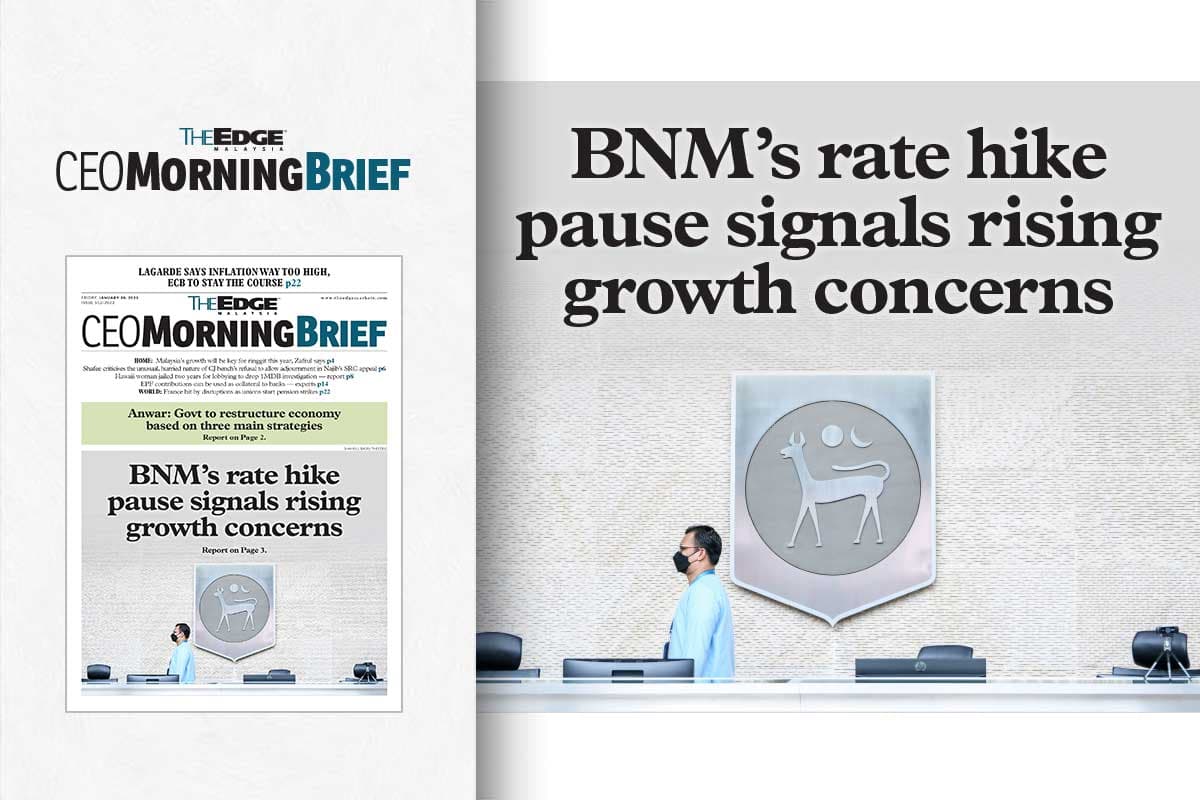
KUALA LUMPUR (Jan 19): Bank Negara Malaysia (BNM), which had to strike a fine balance between encouraging growth and curbing surging inflation last year, decided on Thursday to pause the key rate hike by keeping the overnight policy rate (OPR) at 2.75% at its first Monetary Policy Committee (MPC) meeting of 2023, bucking the consensus estimate of a 25-basis-point (25bps) increase.
The surprise shift, after the central bank moved decisively against inflation by raising the OPR in a series of hikes from its historical low of 1.75% in July 2020 to 2.75% in the last MPC meeting of 2022 in November, highlights its concern over slower domestic growth as the global economy slows.
Both Bloomberg and Reuters' surveys of economists expected an increase of 25bps to the key rate.
OCBC Bank economist Wellian Wiranto said BNM is signalling that growth concerns are starting to manifest more strongly, just as inflation risk has relatively subsided, perhaps with a view that the government fuel and food subsidy regime is likely to stay broadly in place.
BNM is acutely aware of the downside risks posed by external factors beyond the central bank’s control, said Wellian in a report after the MPC's decision.
“It is not that the central banks would no longer pay attention to lingering price pressure. It is just that, in life, everything is in relative terms. And within that rubric, growth concerns will start to dominate more and more going forward. Indeed, in the case of the more export-oriented Malaysia, growth worries have already tellingly superseded those on inflation,” the economist said.
While Wiranto said BNM has essentially declared it is done with rate hikes for now, his colleague Frances Cheung, rates strategist at OCBC Bank, told The Edge the BNM's pause is not necessarily an end to its hiking cycle.
“The central bank needs to assess the impact of past OPR hikes, which is a prudent approach given the usual lag effects. BNM seeing current OPR level as accommodative means there is still room for further tightening should inflation pressure rise further. Bottom line is that future monetary policy is highly data dependent,” said Cheung.
MIDF Research, likewise, said the central bank is adopting a wait-and-see approach to assess the market performances after the 100 bps increase it made last year. “However, we believe the possibility for further normalization of monetary policy remains given that domestic economic data is still showing an upbeat momentum,” said MIDF.
"We believe the current focus of BNM’s monetary policy setting is to ensure a sustainable growth momentum of Malaysia’s economy. With rising core inflation trend and stronger-than-expected domestic demand, we expect the central bank to restore its monetary bullets to pre-pandemic levels to 3% by March. In addition, we opine the central bank (will) normalise its Statutory Reserve Requirement (SRR) from 2% to 3% this year," it wrote.
Headline inflation averaged 3.4% from January to November 2022, peaking in the third quarter. Underlying inflation, as measured by core inflation, averaged 2.9% up to November 2022.
Negative surprise for banks
Investment and economic analyst Pankaj C Kumar noted that the central bank's decision will be disappointing for the banking sector, which has historically leveraged on interest rate uptrend that can translate into stronger net interest income (NII).
“The anticipation has been so high that the BNM will raise rates this year to such an extent that deposit rates are already climbing up. So the market was front-loading that BNM would raise rates. The competition for deposits has been intense in the last couple of weeks,” the former head of research at OSK Research as well as former director of investment at KSK Group Bhd told The Edge.
With the market anticipating two rate hikes in the first quarter of 2023 — one in January and another in March, the 12-month fixed deposit rate of many banks have almost touched the 3% mark, he said.
“But the decision (not to raise the OPR) will help businesses and consumers not be subjected to higher monthly repayments. So banks will be less susceptible to defaults,” said Pankaj.
Modest ringgit appreciation
The rate hike pause is expected to exact downward pressure on the ringgit, which has recently regained some strength — it was trading at 4.307 against the US dollar at the time of writing, versus 4.747 three months ago.
The strong greenback, due to the faster-than-expected padce of interest rate hikes by the US Federal Reserve, has been the main factor pulling down most currencies in 2022.
“As the (US) central bank indicated signs of a slower pace, we notice modest appreciation of other currencies, including the ringgit since November 2022.
“Fundamentally, the ringgit is in a good position as the domestic economy stays on upbeat momentum and as a net exporter of crude petroleum, liquefied natural gas and palm oil, Malaysia stands to benefit from the elevated global commodity prices,” added MIDF.
On top of that, lower domestic political temperature post-GE15 has improved market confidence and injected political stability to Malaysia’s economy as well as its currency.
“Moving forward, we foresee the ringgit to average higher at RM4.30 per US dollar and ending the year 2023 at RM4.23,” the research firm added.
To receive CEO Morning Brief please click here.